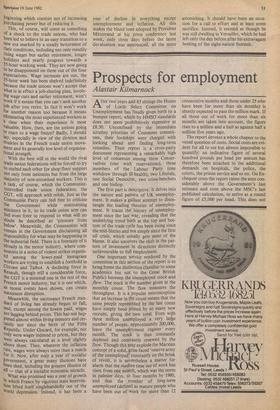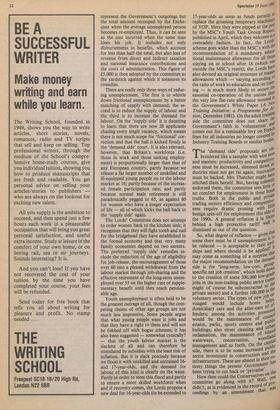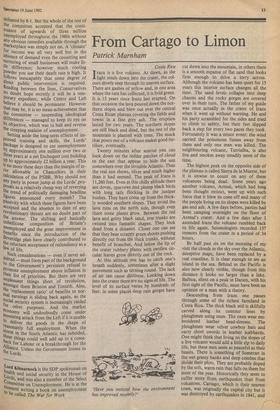Prospects for employment
Alastair Kilmarnock
After two years and 83 sittings the House of Lords Select Committee on Unemployment has finally given birth to a bumper report, which by HMSO standards does not seem prohibitively expensive at £8.50. Unconfined by the immediate scrutiny priorities of Commons commit- tees, their lordships were charged with looking ahead and finding long-term remedies. Their report is a cross-party document representing a remarkably high level of consensus among three Conser- vatives (one with reservations), three members of the Labour Party (one withdrew through ill-health), two Liberals, one Social Democrat, two cross-benchers and one bishop.
The first part is descriptive. It delves into the nature and pattern of UK unemploy- ment. It makes a gallant attempt to disen- tangle the leading theories of unemploy- ment. It traces the history of unemploy- ment since the last war, revealing that the underlying trend both at the top and bot- tom of the trade cycle has been rising since the mid-Sixties and not simply since the first oil crisis, which usually gets most of the blame. It also uncovers the shift in the pat- tern of investment in directions distinctly unfavourable to full employment.
One important service rendered by the committee in this section of the report is to bring home the distinction (familiar to some academics but not to the Great British Public) between the unemployed stock and flow. The stock is the number given at the monthly count. The flow measures the throughput. It is a popular misconception that an increase in the count means that the same people represented by the last count have simply been joined by so many new recruits, giving the new total. Even with three million unemployed a very larke number of people, approximately 200,000, leave the unemployment register every month. The stock is thus constantly depleted and constantly renewed by the flow. Though this may explode the Marxian concept of a solid, grim-faced 'reserve army of the unemployed' constantly on the brink of revolt, it is nevertheless a matter for alarm that the median time out of work has risen from one month, which was the norm in palmier days, to four months by 1980, and that the number of long-term unemployed (defined as mature people who have been out of work for more than 12 consecutive months and those under 25 who have been for more than six months) is shortly expected to pass the million mark. If all those out of work for more than six months are taken into account, the figure rises to a million and a half as against half a million five years ago.
The report devotes a whole chapter to the vexed question of costs. Social costs are evi- dent for all to see but almost impossible to quantify: an indicative figure of several hundred pounds per head per annum has therefore been attached to the additional demands on hospitals, the police, the courts, the prison service and so on. On Ex- chequer costs the report raises the ante con- siderably above the Government's last estimate and even above the MSC's last published calculation, to arrive at a round figure of £5,000 per head. This does not represent the Government's outgoings but the total amount recouped by the Exche- quer when the average unemployed person becomes re-employed. Thus, it can be seen as the cost incurred when the same man loses his job. It includes not only disbursements in benefits, which account for less than half the total, but also loss of revenue from direct and indirect taxation and national insurance contributions and the costs of administration. This figure of £5,000 is then adopted by the committee as the yardstick against which it measures its remedies.
There are really only three ways of reduc- ing unemployment. The first is to whittle down frictional unemployment by a better matching of supply with demand; the se- cond is to reduce the supply of labour and the third is to increase the demand for labour. On the 'supply side' it is daunting to learn that there are now 28 applicants chasing every single vacancy, which means there is not much scope for 'frictional' cor- rection and that the ball is kicked firmly in the 'demand side' court. It is also relevant, however, that Britain's workforce (i.e. those in work and those seeking employ- ment) is proportionally larger than that of any European country, partly because we release a far larger number of unskilled and ill-equipped young people on to the labour market at 16; partly because of the increas- ed female participation rate; and partly because normal male retirement is still paradoxically pegged to 65, as against 60 for women who have a longer expectation of life — all of which kicks the ball back to the 'supply side' again.
The Lords' Committee does not attempt to order women back to the kitchen sink; it recognises that they will fight tooth and nail for the bridgehead they have established in the formal economy and that very many family economies depend on two earners. The preferred 'supply side' remedies in- clude the reduction of the age of eligibility for job-release, the encouragement of those over 60 into a phased withdrawal from the labour market through job-sharing and the effective retirement of the long-term unem- ployed over 55 on the higher rate of supple- mentary benefit until they reach pension- able age.
Youth unemployment is often held to be the greatest outrage of all, though the com- peting claims of other age groups are not much less impressive. Some people argue that what young people want is jobs and that they have a right to them and will not be fobbed off with bogus schemes; it has also been suggested — somewhat cynically? — that the youth labour market is the slackest of all and can therefore be stimulated by subsidies with the least risk of inflation. But it is slack precisely because we flood it with unskilled and untrained 16- and 17-year-olds, and the demand for labour of this kind is clearly on the wane. Partly in order to stem this flood and partly to ensure a more skilled workforce when and if recovery comes, the Lords propose a new deal for 16-year-olds (to be extended to
Spectator 19 June 1912 17-year-olds as soon as funds permit) to replace the groaning temporary machinery of YOP. Here they were pipped at the Post by the MSC's Youth Task Group Report, published in April, which they welcome in a comradely fashion. In fact, the Lords' scheme goes wider than the MSC's with the recommendation of a mandatory educa- tional maintenance allowance for all those staying on at school after 16 (which was outside the MSC's remit); the Lords have also devised an original structure of trainee allowances which — varying according t° the ratio of work to education and/or train" ing — is much more likely to secure the essential co-operation of the unions than the very low flat-rate allowance mooted to the Government's White Paper (11 New Training Initiative: a Programme for Ac' Lion, December 1981). On the adult training side the committee does not share the Government's faith in 'voluntarism' and
,", comes out for a remissable levy on French lines for all industries no longer covered hY Industry Training Boards or similar bodies'
The 'demand side' proposals are ern" broidered like a sampler with wise saws and maxims: productivity and competitive" ness must be increased, slimmed down in- dustries must not get fat again, innovating must be backed. Mrs Thatcher might have stitched them herself. But, having solemnly endorsed them, the committee sees little or no comfort for employment in these home truths. Both in the public andpe ' yaie trading sectors efficiency and competitve- ness require drastic pruning with littler benign spin-off for employment this side °I the 1990s. A general reflation A la SO!, behind a high protective tariff Wall dismissed as out of the question.
So, what degree of reflation — given that
some there must be if unemployment is be reduced — is acceptable to their forlt ships and where should it be apPlied?, may come as something of a surprise tPaci the major recommendation on the denial' side is for 'long-term, low-cost, group' specific net job creation', which boils d°''cl to the creation of some 300,000 low-gra e jobs in the non-trading public sector (some might of course be subcontracted to the private sector) and a further 100,000 i,11 voluntary sector. The types of new jours-, visaged would include home 11111 f, domiciliary care and the after-care 01 of, fenders; among the activities pronno``,1 would be the maintenance of antlificPc estates, parks, sports centres and buildings; also street cleaning and tirb'ej reclamation, the maintenance of inland waterways, conservation, Woodia.n,.; management and so forth. On the caP1Tc side, there is to be some increased PtIbh1 the sector investment in construction and infrastructure. These are almost in their!'., tirety things the present Government has been trying to cut back or `privatise' •e
„
How then could the Conservatives on tri_Ce committee go along with it? Well, didn't, as is evidenced in the record of Pro- ceedings by an amendment that was defeated by 8-1. But the whole of the rest of the committee accepted that the conti- nuance of upwards of three million unemployed throughout the 1980s without any obvious remedies available through the marketplace was simply not on. A 'climate' for success was all very well but in the absence of demand even the cossetting and nurturing of small businesses will make lit tie difference; however much rooting Powder you use their death rate is high. It follows inescapably that some degree of direct public intervention is required. Reading between the lines, Conservatives no doubt hope secretly it will be a tem- PorarY expedient, while Centre and Left believe it should be permanent. However that may be, it is no mean achievement that the committee — suspending ideological differences — managed to keep its eye on its objective, which was to halt and reverse the creeping malaise of unemployment. i Setting aside the long-term effects of m- Proved training and skills, the Lords' Package is designed to cut unemployment by approximately one million over two or three years at a net Exchequer cost building UP to approximately £2 billion a year. This is no more these days than the margin of er- ror allowable to Chancellors in their calculation of the PSBR. Why should not anY Party in power jump at the Lords' pro- Posals as a relatively cheap way of reversing the trend of politically damaging headline figures announced every month? The Passivity with which these figures have been accepted and the absence to date of any revolutionary threats are no doubt part of the answer. The shifting and basically unbellicose composition of Britain's
benefits and the great improvement in
nenefits since the introduction of the Beveridge plan have clearly contributed to the reluctant acceptance of redundancy as a law of life.
Such considerations — even if never ad- mitted — must form part of the background ,0 the Government's persistent refusal to Promote unemployment above inflation in their list of priorities. But there are very unpleasant things short of revolution, amongst them Brixton and Toxteth. Also, the 'replacement ratio' of benefits to nor- mal earnings is sliding back again, as the !faal security system is increasingly raided torci other purposes. And the market economy will undoubtedly come under mounting attack from the Left if it is unable '0 deliver the goods in the shape of reasonably full employment. When the these in the South Atlantic has subsided, things could well add up to a come- back for Labour or a breakthrough for the Alliance. Unless the Government listens to the Lords.
,Lord Kilmarnock is the SDP spokesman on health and social security in the House of Lords and was also a member of the Select Committee on Unemployment. He is at the moment writing a book on unemployment 10 be called The War for Work






































 Previous page
Previous page